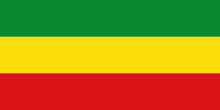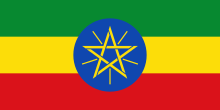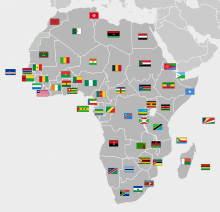Pan-African colors

The pan-African colors are green , yellow and red . They are used in many African national flags and express the feeling of togetherness of these nations. Black is also often used, following the classic colors of the Back-To-Africa movement by Marcus Garvey (red, black and green). The African Union emblem also uses the pan-African colors (with gold instead of yellow).
history
The models for the pan-African colors were the colors of Ethiopia , the only independent country in Africa, which were used as early as the 19th century and were probably created by the union of three pennants , and the flag of Ghana , in which the pan-African idea was consciously expressed for the first time.
Ethiopia is the oldest independent state in Africa. Between 1894 and 1898, the colors green, yellow and red, popular in Coptic folk art, were combined in a horizontally striped tricolor based on the European model. The official interpretation of the individual colors is:
- Green stands for the fertility of the home soil.
- Yellow stands for love for the fatherland.
- Red represents the blood that was shed for the homeland.
In the Empire the following meaning was ascribed to the colors:
- Green was the symbol of the country
- Yellow represented the church, peace, and natural wealth
- Red was the color of the patriots' strength and blood
There is some evidence that the Ethiopian flag was the model for the pan-African colors. Their relatively old age, their role as a symbol of the oldest state on African soil, their catchy meaning, which could also be transferred to other countries, may have made this adoption easier.
When Ghana gained independence in 1957, it adopted a newly created national flag in reverse order, which was a conversion of the flag of President Kwame Nkrumah's Convention People's Party (CPP) . These colors were also used in the unified flag of the Union of African States agreed between Ghana and Guinea in 1958 .
The flags of the Central African Republic and South Africa show the pan-African colors together with the classic European colors red, white and blue. The Central African Republic thus refers to the tricolor of the colonial power France , in South Africa one wants to take into account not only the black but also the white population group in its flag.
Christianity in Africa
Based on the Ethiopian Orthodox Tewahedo Church , the following interpretation is also used in African Christianity . This refers to the Christian Trinity and the Christian virtues.
Then it says
- Green for the Holy Spirit and hope
- Yellow for God the Father and charity
- Red for God's Son and faith
African American popular culture and folklore
During the Afro-American festival of Kwanzaa , a candle is lit in a candle holder called Kinara on each of the seven days. These stand on the one hand for the seven Kwanzaamottos, on the other hand for Africa. These are ideally three red, three green and one black (instead of one yellow).
Rastafarian
The pan-African colors are also the colors of the Rastafarian religion , who revere the last Ethiopian emperor Haile Selassie as savior.
The trigger for the creation was the prophecy of Marcus Garvey in the 1920s of a powerful black king in Africa. The coronation of Haile Selassie, after a coup by the Christian Orthodox aristocracy as emperor of Ethiopia in 1930, was seen as the fulfillment of the prophecy.
The term Rastafari is derived from the maiden name Haile Selassies, namely Ras Tafari Makonnen .
The three colors symbolize:
- "Mother" Africa (green),
- the wealth of the African population that was exploited by the imperialists (yellow)
- and the blood of men that was shed by it (red).
Flags with the Pan-African colors
The following national flags show the pan-African colors (sometimes combined with other colors):
| State / location | flag | Remarks |
|---|---|---|
Ethiopia
|

|
The flag of Ethiopia probably originated from the union of three pennants in the colors green, yellow and red, which are popular in Ethiopia (which, based on the flag of Ethiopia, also became the pan-African colors). |
Benin
|

|
The flag of Benin was introduced in 1958 as the flag of Dahomey, which was then autonomous from France , and was retained after independence in 1960. At the time of the military dictatorship (1975 to 1990) it was replaced by a green with a red star and then restored. |
Burkina Faso
|

|
The Burkina Faso flag was officially introduced in 1984. Red stands for the blood shed by the martyrs of the revolution, green for the fertility of the land and the yellow star is the symbolic guiding star for the democratic people's revolution. |
Eritrea
|

|
The flag of Eritrea was introduced in 1993. Green stands for the fertility of the land or agriculture, blue stands for the abundance of the sea, red stands for the shed blood of the struggle for freedom. |
Ghana
|

|
The model for the flag of Ghana was the flag of Ethiopia, the color of which was reversed. |
Grenada
|

|
The flag of Grenada was introduced in 1974. Red stands for harmony and unity and indicates the courage that was necessary to achieve independence, yellow stands for the sun and the friendliness of the inhabitants and at the same time for wisdom and green expresses the fertility of agriculture, the economic basis of the Country. Grenada is not in Africa. |
Guinea
|

|
The flag of Guinea is borrowed from the French tricolor, as the country was a French colony until its independence in 1958. |
Guinea-Bissau
|

|
The flag of Guinea-Bissau emerged from the flag of the independence movement PAIGC (Partido Africano da Independência da Guiné e Cabo Verde), which used the pan-African colors red-yellow-green. After independence was achieved in 1973, the PAIGC lettering under the black star was removed. |
Jamaica
|

|
The flag of Jamaica was introduced in 1962. Green stands for hope and agriculture, yellow or gold symbolizes the rich natural treasures of Jamaica and the beauty of sunlight and black is a reminder of the difficult days of the past and the present (poverty). Jamaica is not in Africa. |
Cameroon
|

|
The model for the vertically divided flag of Cameroon is the French tricolor. |
Kenya
|

|
The flag of Kenya was introduced in 1963. Black stands for the black people, red stands for the blood shed with a lot of courage and bravery , green for the fields and forests of the country and white for the peace between the past and the future of the black man in Africa and the unity of the peoples. |
Libya
|

|
The flag of Libya was originally introduced in 1951 and, after a phase of 2 pan-Arabic and an Islamic flag, was restored in 2011. Red stands for the blood in the fight against Italian colonialism, green for prosperity and black for the royal family. |
Republic of the Congo
|

|
The flag of the Republic of the Congo was originally introduced in 1959 and, after a phase with a socialist flag, was restored in 1991. |
Malawi
|

|
The old flag of Malawi from 2010 to 2012 showed a complete, white sun to symbolize the progress in the development of the country since independence. Black stands for the people of the African continent, red stands for the blood of the martyrs that was shed in the struggle for freedom and green stands for the lush forests of Malawi. |
Mali
|

|
The flag of Mali is based on the French tricolor and is reminiscent of the French colonial era. The original flag of Mali was adopted on April 4, 1959, and featured a black human figure , known as the Kanaga symbol , in the center . |
Mauritania
|

|
The colors of the flag of Mauritania, green, yellow and red, indicate the considerable proportion of the black African population. The color green and the crescent moon symbolize Islam , the main religion of the country. The stripes added in 2017 symbolize the blood of those who fought for Mauritania's independence. |
Mozambique
|

|
The flag of Mozambique is based on the old flag of the freedom movement FRELIMO ( Frente de Libertação de Moçambique ). |
Zambia
|

|
The Zambian flag was introduced in 1964 and is based on the colors of the United National Independence Party . Green stands for the fields and forests that take up the largest area of the national territory; Orange symbolizes the mineral treasures, especially copper; Black is the skin color of the population and red is a reminder of the struggle to achieve freedom. |
St. Kitts and Nevis
|

|
The flag of St. Kitts and Nevis was introduced in 1983. Green stands for fertility , red is a reminder of the fight against slavery and colonization to achieve freedom, black stands for the country's African heritage and yellow symbolizes year-round sunshine . St. Kitts and Nevis is not in Africa. |
Sao Tome and Principe
|

|
The flag of São Tomé and Príncipe is based on the flag of the independence movement MLSTP, introduced in 1972. |
Senegal
|

|
The flag of Senegal comes from a time when Senegal and French Sudan formed the so-called Mali Federation in early 1959. At that time there was a stylized black human figure in the yellow stripe. When Senegal left this federation and became a republic, people were replaced by a green star of freedom. The stripe flag is obviously inspired by the French tricolor and expresses the solidarity with Ghana and Guinea. |
Zimbabwe
|

|
The flag of Zimbabwe shows seven bars in the colors green, gold, red, black, red, gold, green and, starting from the shaft, a white, black-rimmed triangle with a red five-pointed star, covered with a golden, nesting bird turned towards the shaft. |
South Africa
|

|
The flag of South Africa was introduced in 1994. Red stands for the blood that was shed during the liberation struggles, blue for the two oceans and the sky and white for the white population and for peace. Another interpretation is that black stands for the black majority of the population, green for natural resources and yellow (or gold) for the wealth of natural resources. |
South Sudan
|

|
The flag of South Sudan was introduced in 2011. Black represents the population of Africa; White for the peace that has cost many lives; Red for the blood of the honorable freedom and justice fighters who lost their lives in the many years of conflict ; Green for the agricultural potential of the fertile soils and equatorial vegetation that adorn South Sudan; Blue for the Nile , the main source of life, not only for South Sudan, but also for the north as far as Egypt and the star for the unity of the state of South Sudan. |
Togo
|

|
The flag of Togo was due to a flag competition. The winners Ahyi Paul and another compatriot consciously chose the pan-African colors. |
Chad
|

|
The flag of Chad is a combination of the French tricolor and pan-African colors. |
Central African Republic
|

|
The flag of the Central African Republic is also a combination of the French tricolor and pan-African colors. |
Some historical flags also used the Pan-African colors:
Flag of the Empire of Abyssinia (1897–1936, 1941–1974)
Flag of the Derg (1974-1987)
Flag of South Kasai (1960–1961)
Other green, yellow and red
Different countries use the colors green, yellow and red without any connection to Africa. Sometimes the meanings “vegetation, wealth and blood” are identical, sometimes there are local reasons for the choice of color.
See also
Web links
- Flags of the World - Pan-African colors (English)
Individual evidence
- ^ Whitney Smith : Coats of arms and flags of all nations ("Flags and arms across the world"). Battenberg Verlag, Munich 1981, ISBN 3-87045-183-1 .
- ↑ www.aljazeera.com/news/2017




























